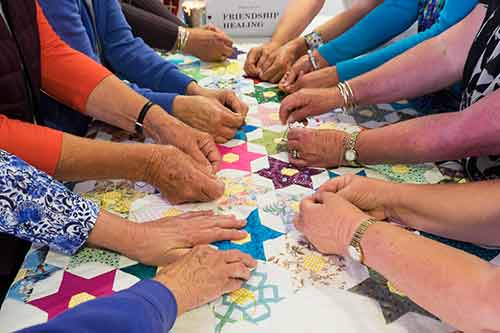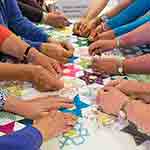
I have already reflected on a Eucharist at St Andrew’s, Plimmerton, and there is another part of that service I want to reflect on.
After receiving communion, most persons of the congregation stopped by a nearby quilt hanging vertically. Each of these persons tied a knot in one of the threads protruding from it, stopping to silently pray.
When I asked about it afterwards, I was told that this parish is the first New Zealand Chapter of the Prayer Quilt Ministry. There was a leaflet available about this in the foyer.
People make a quilt, add these knots prayerfully to threads as I have described, and then give the quilt to someone who has asked for one or who is in need and who has agreed to receive one.
The organisation’s website says:
Can you touch a prayer?
Can you pull it close and feel its comfort?
You can if it’s part of a Prayer Quilt from Prayers & Squares, the Prayer Quilt Ministry.
Some, reading this post, might want to reflect if this is something you might like to begin doing in your community.
I also want to press the reflection a little further – around “touching a prayer”. There are natural human tendencies to have outward, visible signs of inward, hidden, spiritual realities. This is the foundation of our sacramental life, and I think we live in a sacramental universe.
Touching prayer goes right back to using handkerchiefs and aprons that had touched Saint Paul (Acts 19:12).
This is a year particularly to remember, celebrate, and reflect on the Reformation. I have visited many church buildings in the UK and Europe where the art was destroyed and vandalised through the Reformation period – outward visible signs were denounced. Little by little we are back-peddling from that Reformation condemnation of our God-made human tendency and need that the invisible be made visible.
Any number of outward signs are returning to use: candles, stained glass, icons, vestments, ash,… And new outward signs, such as a prayer quilt, are being drawn into this movement.
What do you think?
If you appreciated this post, consider liking the liturgy facebook page, using the RSS feed, and/or signing up for a not-very-often email, …




There is a Presbyterian group in the US that is suggesting mixing Ash Wednesday ashes with glitter for the mark to show that churches support LGBTQ Christians & non-Christians.
Snooty Episcopalians/Anglicans, even the members of the LGBTQ community, are turning their nose up at it.
I just wonder if it is maybe too much. Others see it as an opportunity to insult Presbyterians.
The iconoclasm and antipathy to “smells and bells” among some of the Protestant Reformers always puzzled me.
After all, human beings are made up of body and spirit, and we often perceive spiritual realities through our physical senses.
Bare walls and spoken word only seriously diminish that experience and deny our incarnational nature as human beings.
Consider how differently we feel when someone just says “I love you” and when someone says “I love you” and backs it up with a hug and a kiss.
Totally different experience!
So “outward signs” are healthy and helpful prompts to inner growth in our spirituality.
How many of us, after loosing one very dear to us, a mate, spouse, or child, relish a piece of clothing that we come upon that has not been laundered since they died and still carries their scent?
The sense of smell is very important in evokng locked away memories, some good, others bad.